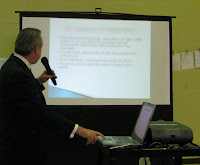 Tech trends come and go. Some re-emerge at later dates, using improved technology and ideas to refine a product. Staying current with trends requires a bit of reading, attending conferences and subscribing to newsfeeds. If you have the passion for technology, you’ll turn into a loyal reader of certain blogs, magazines and social media outlets to gather the inside scoop.
Tech trends come and go. Some re-emerge at later dates, using improved technology and ideas to refine a product. Staying current with trends requires a bit of reading, attending conferences and subscribing to newsfeeds. If you have the passion for technology, you’ll turn into a loyal reader of certain blogs, magazines and social media outlets to gather the inside scoop.For a student pursuing a computer science degree to the tech consultant wanting to keep track of new software and gear, some ways prove more effective at helping you stay tuned to what’s releasing soon. From print media to Web media, each serves its purpose in exposing you to new trends.
Social Media
Compared to print and Web media, social outlets serve as a great source for connecting fans with the creators of new technology. Simply add or subscribe to an electronic giant’s news feeds or tweets and get the inside scoop on the latest ideas engineers seem actuated to design. Pictures, clues and even snippets of information manage to leak onto social media websites that let you validate rumors and even get a glimpse of new software and hardware.
Many of the social outlets are run by CEOs while others become managed by marketing companies to discuss new technology and to gather feedback from community members. These insiders will give you the most recent statuses on new projects, show you beta builds of a piece of software and some may even include a video or two about a recently completed project.
Web Media
Social media works great for granting inside access to fans, but Web media, such as blogs, websites and videos, let the enthusiast read, see and interact with the latest tech trends arriving soon. Some websites aim to attract readerships interested in rumors, such as the case with MacRumors, a website dedicated solely to Apple products.
 Other Web media outlets use their well-placed media sources to gather facts, quotes and news stories from heads of electronic companies to help readers stay informed. With RSS feeds and newsletters, individuals can subscribe to all the latest information in order to stay current with the technology trends.
Other Web media outlets use their well-placed media sources to gather facts, quotes and news stories from heads of electronic companies to help readers stay informed. With RSS feeds and newsletters, individuals can subscribe to all the latest information in order to stay current with the technology trends.One of the newer forms of Web media – podcasts – also work great at providing information from tech news giants or large electronic companies. As with RSS feeds and newsletters, individuals can use subscribe to podcasts to hear the latest on tech trends. With playback options, users can listen to a podcast anytime they wish from their MP3 device or computer.
Conferences
Large tech conferences aim to accomplish one goal: Bring together the biggest players in the industry to show off and discuss new products and software making its way to the market. Attending one of these conferences makes for a surefire method of staying on top of current trends arriving, but also, makes for a spectacle for playing with new devices.
For teachers managing computer classes, tech conferences will lend an inside scoop as to the latest trends in software and hardware, from newer specs on computers, new chip sets arriving and even the most current security patches being implemented into systems. Conferences also make for a great place to network and rub shoulders with executives and software engineers. Networking aside, you’ll be showered in pamphlets, vibrant gadgets and colorful displays.
The key to staying up to date on current tech trends is by reading, attending and having a passion for the industry. Staying in tune can help you better attend to customers, avoid excess spending and clue you in on new gear soon to be released.
Sources
Summa Technologies (2011)
Yahoo (2010)
Captain Joe
Follow me on Twitter @JPuglisiLLC














